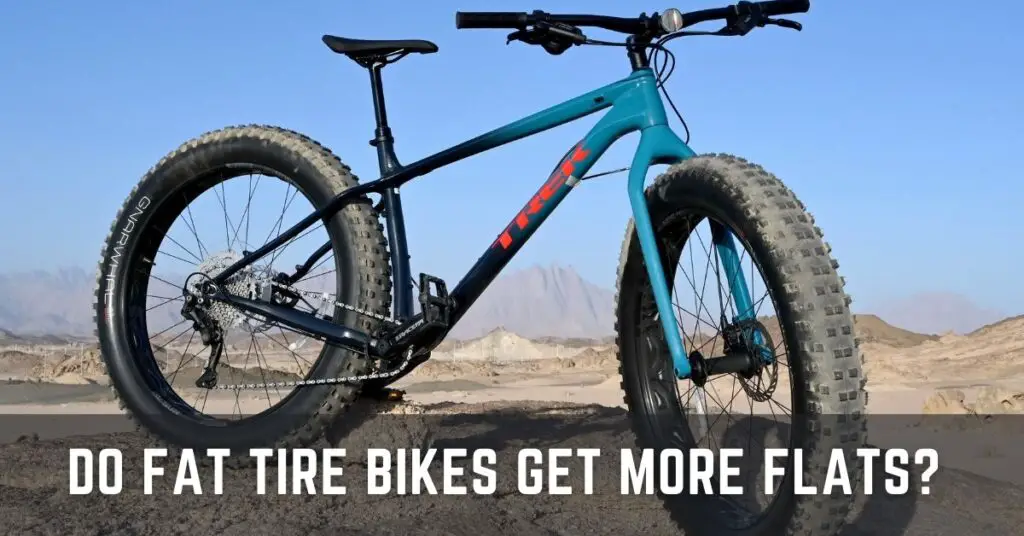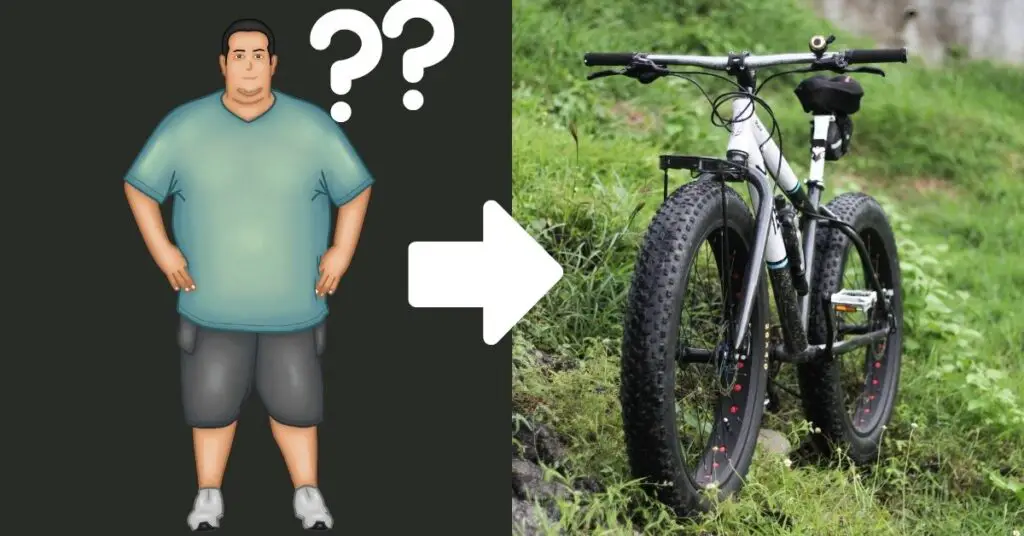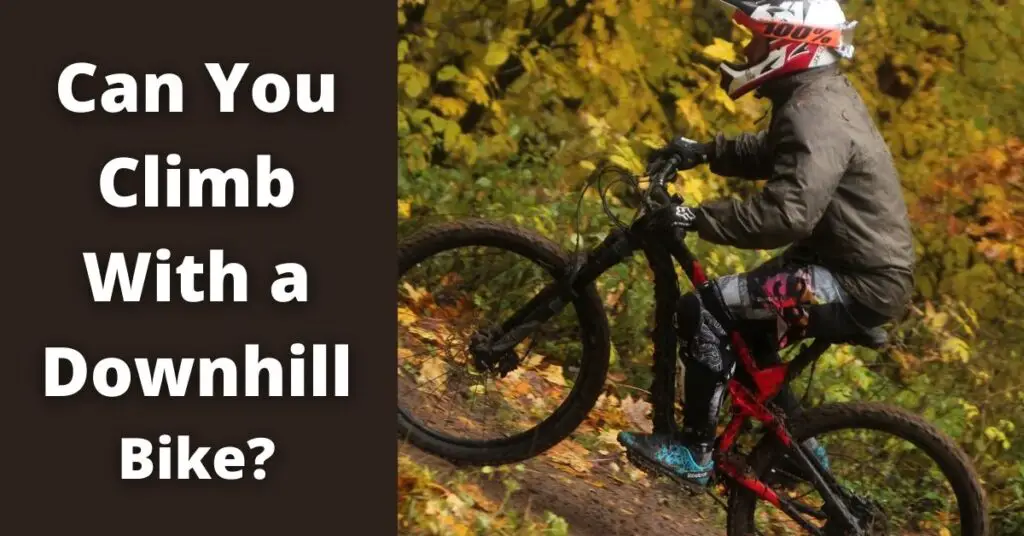Cyclists worry about flat tires as these not only pose risks of injury to the rider by accidents due to poor bike handling that will occur with a punctured tire but also damage the rim itself.
Sharp objects contribute to most of the flats that happen to bikes but a worn-out tire or damaged valve can also lead to leaks and eventual flats.
Now it is natural to wonder if different kinds of tires perform differently when it comes to tire punctures. A fat bike, as the name suggests, has wider and fatter tires than its other rivals such as road bikes or mountain bikes. Will these fat tires suit you if you are worried about flat tires? We’ll be talking about just this in the article!

Do Fat-Tire Bikes Get More Flats?
Fat bike tires do not get more flats than other bikes. In actuality, their increased surface area and thick tire material make them more resistant to punctures. Thinner tires have less air volume as well as high pressure so they handle shocks and pressures poorly.
Many cyclists prefer bikes with wider tires because of how strong they are and how versatile they are in being ridden on a wide variety of surfaces.
If you’re worried about your bike getting too many flats or you live in a place with rough roads, then fat tire bikes are the better bicycle choice for you.
Comparison with Other Bike Types (For Flat Tires!)
So, you want to go for fat tire bikes but need a comparison with other types of bicycles to make your decision. We’ve got you covered. Check out our detailed comparison below.
Road Bike vs Fat Tire Bike
The standard design of a road bike usually has a light frame, thin tires, and curved handlebars. They are also the preferred bikes for riding on paved, smooth roads but the last option for riding on other types of surfaces.
However, road bikes are more susceptible to flats because of the thin tire design. The tires only have a thin rubber tube around a sharp rim, and when you place your weight on it, it stretches and becomes even narrower. Combine this with high speeds on rough terrains, and you have a tire that always gets flats.
Compared to road bikes, fat tire bikes are preferable because they have a stronger tire structure (Thicker tire and wider rim) and are more resistant to flats, whether on smooth or rough terrains.
Mountain Bike vs Fat Tire Bike
Mountain bikes are more similar to fat tire bikes than road bikes. They are built to be ridden on rough roads, outdoor trails, and adverse weather conditions and have a thick frame and knobby tire design.
However, it is not easy to say which bike is more susceptible to flats between a mountain bike and a fat tire bike. For mountain tires, the frequency of flats depends on the type of outdoor surfaces the cyclist explores, specific tire construction, rider’s weight, and other factors.
The thinner mountain bike tires are almost as susceptible to flats as a road bike, but the thicker ones are much harder to penetrate. The thicker ones can be on the same resistance level as fat-tire bikes.
Hybrid Bike vs Fat Tire Bike
The general ranking for tire thickness and width in bicycles places hybrid bike tires between road and mountain bikes. This means the tires in hybrid bikes are wider than road bikes but not as wide as mountain bikes.
This directly impacts the resistance of hybrid bike tires to puncture and pinch flats. Hybrid bikes can sail smoothly on paved and not too rough roads, but once you add in outdoor trails, adverse weather, and larger obstacles, things can take a different turn.
Hybrid bikes also usually don’t have suspension and have a lower puncture resistance than fat-tire bikes and the other two mentioned types. This makes them more susceptible than fat tire bikes on paved and outdoor surfaces.
Can You Ride a Fat Tire Bike on the Pavement? (Will It Get Flats?)
You can ride a Fat bike on pavements. One reason why fat tire bikes are so popular is how versatile they are.
They were designed for off-road terrains and are very popular amongst mountain bikers, but this doesn’t mean you can’t use them on other types of surfaces, such as pavements.
They can work just fine even on other smooth surfaces, but you should know that they will not be as fast or as effective as slimmer tires on these surfaces.
They will be slower and harder to steer and maneuver because of their bulky frames and extra rubber.
Tire Punctures!
Pavements always have much more debris such as nails, sharp objects, and pieces of broken bottles lying over them than the usual bike paths. This makes the bikes more susceptible to getting pinch flats on pavements.
Also, the odds of getting flats increases because the cyclist climbs on and off the pavements frequently thus hitting corners made of concrete.
If you want to enjoy a day out, slow riding by yourself or with a loved one, or if you are a tourist, a fat tire bike is a good choice for you. So, you can use any fat tire bike without any worries and enjoy a comfortable ride.
Are Wider (Fat) Tires Better in the Rain? Chances of Getting Flats!
When it comes to rain and wet conditions, wider tires are better for more grip, control, and movement. They have more rubber which means more traction to cut through the wet surfaces and prevent slipping.
They also have more volume in the tire, which means lower pressure and a smoother ride on wet paved roads.
The water on the road (or bike path) makes it easy for sharp and even-less-sharper objects to “pinch” their way into the tires because of lubrication.
Wider tires are also really good at cutting against wet debris such as leaves, rocks, debris, etc.
The only problem that might come up is if there is heavier rain and you will be riding through several puddles. This can really slow the tires down and keep you in the rain longer.
As stated earlier, fat tire bikes are designed to be very effective on rough and rocky terrains. This means they can handle wet, uneven surfaces, muddy terrains, etc.
How to Make Bike Tires Puncture-Proof?
Of course, having to fix your tire all the time gets tiring fast. It would be so nice to have puncture-proof tires, and it is possible. Here is how you can do it using an old tire.
Step 1: Use a spanner to unscrew your wheel from your bike and then carefully remove the tube from the bike. Set both aside and then grab the old wheel.
Step 2: Use a knife to cut away the edges of the old tire until all you have left is the flat section of it that can easily fit into your current tire. Insert the cut tire into your tire like you are lining the inside.
Step 3: Put a new tube into the tire, but first, you must pump it with some air so that it is firm. Ensure that the tube’s air valve is in line with and properly attached to the valve hole.
Step 4: Now, you can attach the tire back onto the rim and pump it until it is firm and tight. Reinstall the wheel onto the bike and tighten it carefully. Now, you have your very own puncture-proof tire!
How Do You Fix a Flat on a Fat Bike?
Repairing a flat tire and fixing minor issues like a flat might require more effort than when you do it on a narrow tire, but this doesn’t make it a difficult task, You can do it by yourself at home with the right tools and guide. So, here is a simple guide on how to fix the flats in your fat tires.
Step 1- Use a wrench to loosen the wheel and fishtail washers from your fat bike and carefully detach the tire with the flat.
Step 2- Carefully remove the bead and valve stem from your tire and remove the rim. After this, you can remove the tube from the tire and set it aside. Be careful to place everything where it is easy to pick and reattach.
Step 3- Feel the inside of the tire for where the item(s) that punctured it is and carefully remove it. Mark where the object punctured the tire and the tube.
Step 4- Using the tire patch kit you have chosen, carefully sand and scour the area where the hole is in the tube. Then apply the glue to the spot and the area immediately outside it.
Step 5- Stick on your rubber patch carefully and let it sit for about 10 minutes. This should be enough time for the adhesive to properly stick to the rubber patch. Smooth it carefully to ensure there are no bubbles and patch any other places that have been punctured.
Step 6- You can use Gorilla Glue tape here to line the inside of the tire itself so that any holes there are also blocked. Carefully line the inside and smoothen the tape.
Step 7- Put your tire back together correctly, ensuring that everything is in its proper place. Pump air into your tire until it is firm and tight, bounce it occasionally to help the bead get sealed, and monitor the pressure, so you don’t over pump it.
Step 8- Now, you can mount your tire back onto your fat bike. Ensure your fishtail washers are in the right place and use the wrench to tighten the nuts into position. Ensure that your tire is securely placed and you’re good to go.
Final Thoughts!
With all this new information about fat-tire bikes and how you can make your tires puncture-proof, there are so many ways for you to improve your cycling experience and make it more enjoyable for you.
We hope that our guide was helpful and taught you more about what it would be like to use and maintain a fat tire bike.




